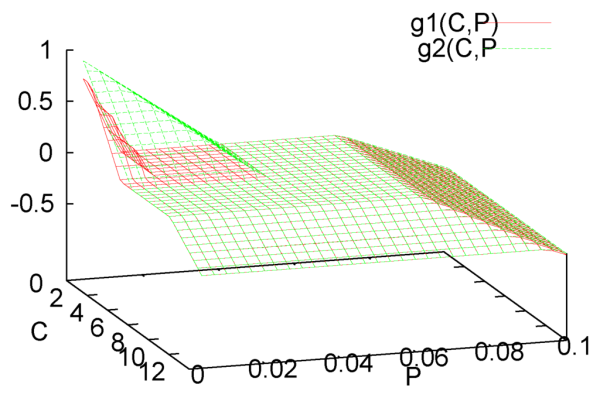Abstract:
We study a previously introduced mathematical model of amensalistic control of the foodborne pathogen Listeria monocytogenes by the generally regarded as safe lactic acid bacteria Lactococcus lactis in a chemostat setting under nutrient rich growth conditions. The control agent produces lactic acids and thus affects pH in the environment such that it becomes detrimental to the pathogen while it is much more tolerant to these self-inflicted environmental changes itself.
The mathematical model consists of five nonlinear ordinary differential equations for both bacterial species, the concentration of lactic acids, the pH and malate. The model is algebraically too involved to allow a comprehensive, rigorous qualitative analysis. Therefore, we conduct a computational study. Our results imply that depending on the growth characteristics of the medium in which the bacteria are cultured, the pathogen can survive in an intermediate flow regime but will be eradicated for slower flow rates and washed out for higher flow rates.
By: Dr Hassan Khassehkhan

This article, published in Foods (2016), presents a computational study exploring the amensalistic control of the foodborne pathogen Listeria monocytogenes by Lactococcus lactis in a nutrient-rich chemostat environment. The study develops a mathematical model consisting of five nonlinear ordinary differential equations to describe the dynamics of two microbial populations (L. monocytogenes and L. lactis), along with lactic acid (C), hydrogen ions (P), and malate (M) concentrations. The model incorporates 18 parameters to account for growth kinetics, inhibition effects, and reactor operating conditions such as flow rate and bulk concentrations of growth inhibitors.
The research investigates how L. lactis, a lactic acid bacterium, can suppress L. monocytogenes through the production of lactic acid and hydrogen ions, which create an unfavorable environment for the pathogen. The model considers both batch and chemostat settings, with a focus on the impact of flow rate and initial concentrations of inhibitors on microbial persistence. Simulations reveal that the pathogen’s survival depends on low concentrations of detrimental substances and a flow rate that does not exceed bacterial growth rates. At lower flow rates, L. lactis effectively outcompetes L. monocytogenes due to its higher tolerance to inhibitors, leading to pathogen eradication. At higher flow rates, both species may wash out.
The study also examines the effect of continuously adding L. lactis as a control agent, finding that higher flow rates enhance eradication efficiency, reducing pathogen eradication time significantly (up to 47% at high flow rates). However, increasing the control agent dosage beyond a certain threshold yields diminishing returns. The model highlights the importance of balancing flow rates and inhibitor concentrations to optimize pathogen control while considering practical constraints like cost and microbial side effects.
Due to the complexity of the five-dimensional system, the study relies heavily on numerical simulations rather than analytical solutions, noting that traditional chemostat theories are less applicable due to the amensalistic interaction rather than resource competition. The findings suggest that L. lactis can be an effective biocontrol agent for L. monocytogenes in food preservation, with implications for improving food safety in products like dairy and ready-to-eat meats.
Download the article to read:
 | AComputational Study of Amensalistic Control of Listeria monocytogenes by Lactococcus lactis under Nutrient Rich Conditions in a Chemostat Setting |

